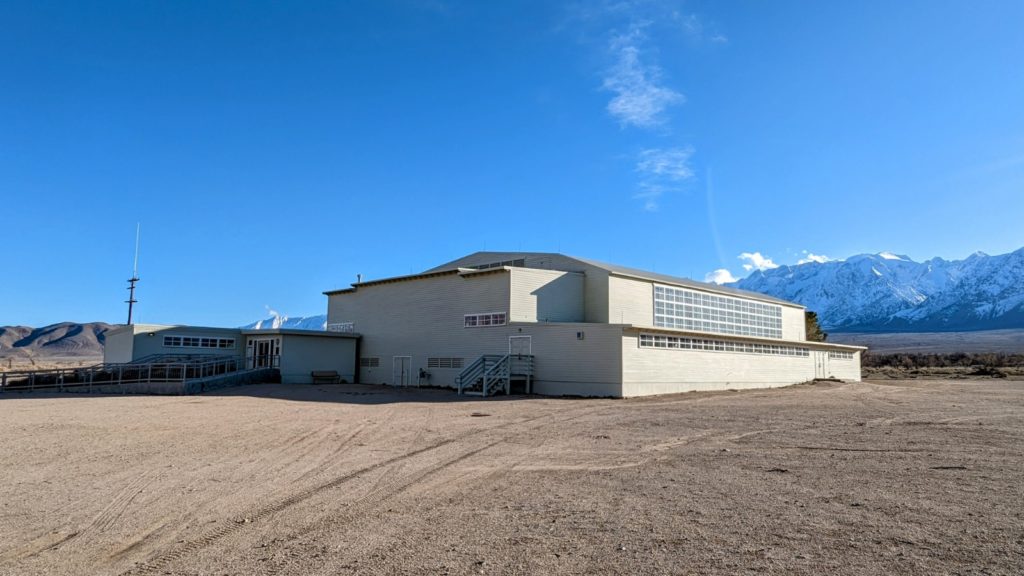Today we spent the afternoon at Manzanar National Historic Site. This is a place we had never heard of until we came to this area, and we really weren’t expecting there to be much to do there. We were thinking we would probably be there for an hour or so and then on to something else. We ended up being there for over four hours and could have stayed longer if they weren’t closing down the buildings for the day. If you ever decide to visit this site and you are the kind of person who likes to read the displays, study the artifacts, and truly understand and learn, our advice is to plan for at least four hours, maybe longer. We have actually kicked around the idea of going back another day to finish our explorations.
Now, you are probably wondering what Manzanar even is. Manzanar is one of ten camps that confined over 120,000 Japanese Immigrants and Japanese Americans, including 70,000 US citizens, during WWII. Manzanar housed over 10,000 of these people. Intellectually, we both knew that this had happened in our country’s past, but reading the stories and hearing directly from some of those held there, really made it hit home for us. What a dark, dark time in our history. We aren’t going to give you a history lesson. If you are interested in the history of what happened, there are certainly plenty of resources for you to do your own research. There are a few things that stood out to us during our visit, though, that we would like to share.

First, everyone was housed in barracks. Manzanar was arranged into 36 blocks that each contained 14 barracks. Each barrack had four rooms and there were eight people assigned to each room. Families stayed together, but would often be housed with complete strangers to fill the room. All meals were eaten in public mess halls, so the family meal was a thing of the past, and bathrooms and showers were basically just big rooms with little to no privacy to be shared by everyone in the block. Can you imagine being forced to live that way when you had done absolutely nothing wrong? We can’t imagine how de-humanizing that would be.


One thing that really surprised us, though, was the spirt of the people residing in Manzanar. Many people in this situation would have been so discouraged and dejected that they would have allowed that to rule their lives, but the people in Manzanar got to work doing what they could to make things better. They landscaped the grounds and created beautiful gardens with water features, plants, and rocks. They started sports leagues to play baseball and enjoyed judo. And they personalized their barracks by improving the buildings themselves as well as building furniture from fruit crates to improve their way of life. (The furniture they made from the fruit crates were gorgeous pieces that we would be proud to have in our home!)

Unfortunately, 150 people died while at Manzanar and did not see freedom again in their lifetime. Most of those people were cremated or sent to be buried in their hometowns, but 15 were buried at Manzanar. Of those, nine were later moved by their families, but there are still six people laid to rest in the cemetery. There is a beautiful monument erected there with the Sierra Nevada Mountains in the background. The inscription on the monument are characters that mean “soul consoling tower” and it is still often visited by descendants of those who were confined here and is seen as a symbol of solace and hope.

The photo above is a picture of the fire station for the camp and in the distance is a reconstructed guard tower. This struck us. Can you imagine being a US citizen, or an immigrant for that matter, who has done nothing AT ALL wrong and are forced to live within a barbed wire fence with guards watching over you at all times? We cannot. The people who lived in Manzanar were not criminials. They were law-abiding contributors to society who just happened to come from, or have ancestors who came from, the wrong place as deemed by the government. As a society, we still have far to go, but may we learn from history and not repeat the crimes and mistakes of our forefathers.
Until next time!


Never really thought about there being a site in the U.S. commemorating the internment camps. A quick check online though, shows that there are preservation efforts underway at most of the ten sites. I would definitely take the time to visit Manzanar or one of the others, if I was close. Thanks for sharing!
It was a very educational and sobering visit. We recommend it to everyone.